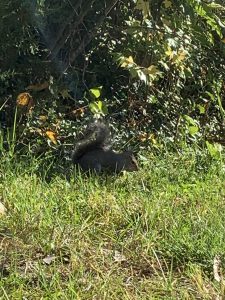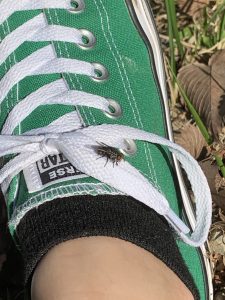Katie Blog 3 | October 21st, 2020 | 83 Degrees and Sunny | 2:58-4:05
The sun was bright and scorching today—clear blue skies and 83 degrees, way hotter than I was expecting on a mid-October day. I spread out my blanket and laid back, taking in my surroundings. I began this sit spot with 15 minutes of quiet observation and focus. During this time, I was acutely aware of the sun beating down on my shoulders. The grasses around me have started to die, turning dry and brittle while revealing the rocky ground underneath. Fallen leaves covered the ground, most of which were intact. After picking up a few of these leaves, I thought back to the leaf decomposition lab and began to wonder how long these leaves will be present before decomposing. Since this area appears to be mowed frequently, I predict this will result in a quicker rate of decomposition as the leaves will become shredded. The creek was moving slowly—the pathway was clogged with fallen leaves. Unlike last week, the rocks in the creek were no longer submerged underwater as the water level was much lower due to infrequent rainfall. No crayfish or other invertebrates were present.
While tuning into my auditory senses, I began to pick up on singing originating from either Beale Garden or the chapel. I heard a woman singing some type of opera music. It was a beautiful, clear tune. After she finished her song, I heard a few people around her talking and laughing. Soon, a group broke into song—a modern pop song, however, I could not make out the individual words. My spot is typically far enough from human contamination, but this was a beautiful experience to overhear. On a more natural note, the squirrels were definitely creating quite the ruckus today. The cluster of trees behind me came alive with the sound of 3 individuals scurrying around through the leaf litter. At one point, a squirrel came within 10 feet of my spot and buried a large nut or seed.
 A squirrel burying a nut for winter
A squirrel burying a nut for winter
I was able to identify three species today, including an interesting clump of moss. According to iNaturalist, this is a species called Redshank (Ceratodon purpureus). This type of moss was common in multiple areas around my spot. This is a very adaptive species and has the ability to thrive in varying conditions including urban areas and heavily contaminated soils. A large fly landed on my shoe and I was able to quickly snap an image. According to research, this fly belongs to the subfamily Calliphoridae. Within this subfamily, there are nine genera. The third species I saw was a group of water skippers of the family Gerridae. I could not get a close picture of this organism, but they were present in groups of 4-5 individuals both upstream and downstream. Water skippers are considered pleuston animals (surface living) and are able to walk on the water’s surface due to weight distribution.
 Redshank (Ceratodon purpureus)
Redshank (Ceratodon purpureus)
 A fly from the subfamily Calliphoridae
A fly from the subfamily Calliphoridae
Coming to my sit spot today provided a great break from the everyday stressors of campus life. As the leaves from the surrounding trees fell softly around me, I was thankful for the beauty of nature. After being cooped inside for far too long, the quiet sounds of nature, warm sun, and cheery calls of people in the distance was just the thing I need to brighten my day.


I liked how you described the auditory senses. Very detailed!
Nice blog Katie!